Women-Oriented Evaluation of Perceived Safety of Walking Routes between Home and Mass Transit: A Case Study and Methodology Test in Guangzhou
Abstract
1. Introduction
2. Literature Review
2.1. Street Safety and Female Safety
2.2. New Data and Technology for Measuring Street Safety Levels
2.2.1. Street View Images and Deep Learning
2.2.2. Subjective Perception and Machine Learning
2.2.3. Simulation of Street Pedestrian Flows
2.3. The Gaps
3. Study Area, Framework, and Data
3.1. Study Area
3.2. Conceptual Framework
3.3. Data
3.3.1. Road
3.3.2. SVIs
3.3.3. Subjective Safety Perception Evaluation
3.3.4. Mobile Phone Data
3.3.5. Public Transport Station
4. Methods
4.1. Machine Learning
4.1.1. Streetscape Feature Classification
4.1.2. Predicting Subjective Scores
4.2. Calculating Female Commuting Paths
5. Result and Discussion
5.1. Differences in Perceived Safety between the Three Groups
5.2. Safety Score Map
5.2.1. Selection of ML Models
5.2.2. Subjective Safety Perception of Urban Street
- (1)
- Safety score map
- (2)
- Validation of subjective safety perception scores
5.2.3. Combined Analysis of Street Safety Score and Street Pedestrian Flows
5.2.4. Factors Affecting Subjective Safety Perception
6. Discussion
6.1. The Application of Female-Dominated Safety Perception Assessment
6.2. Strategies for Street Improvement
6.3. The Research Limitations
7. Conclusions
Author Contributions
Funding
Institutional Review Board Statement
Informed Consent Statement
Data Availability Statement
Conflicts of Interest
Appendix A
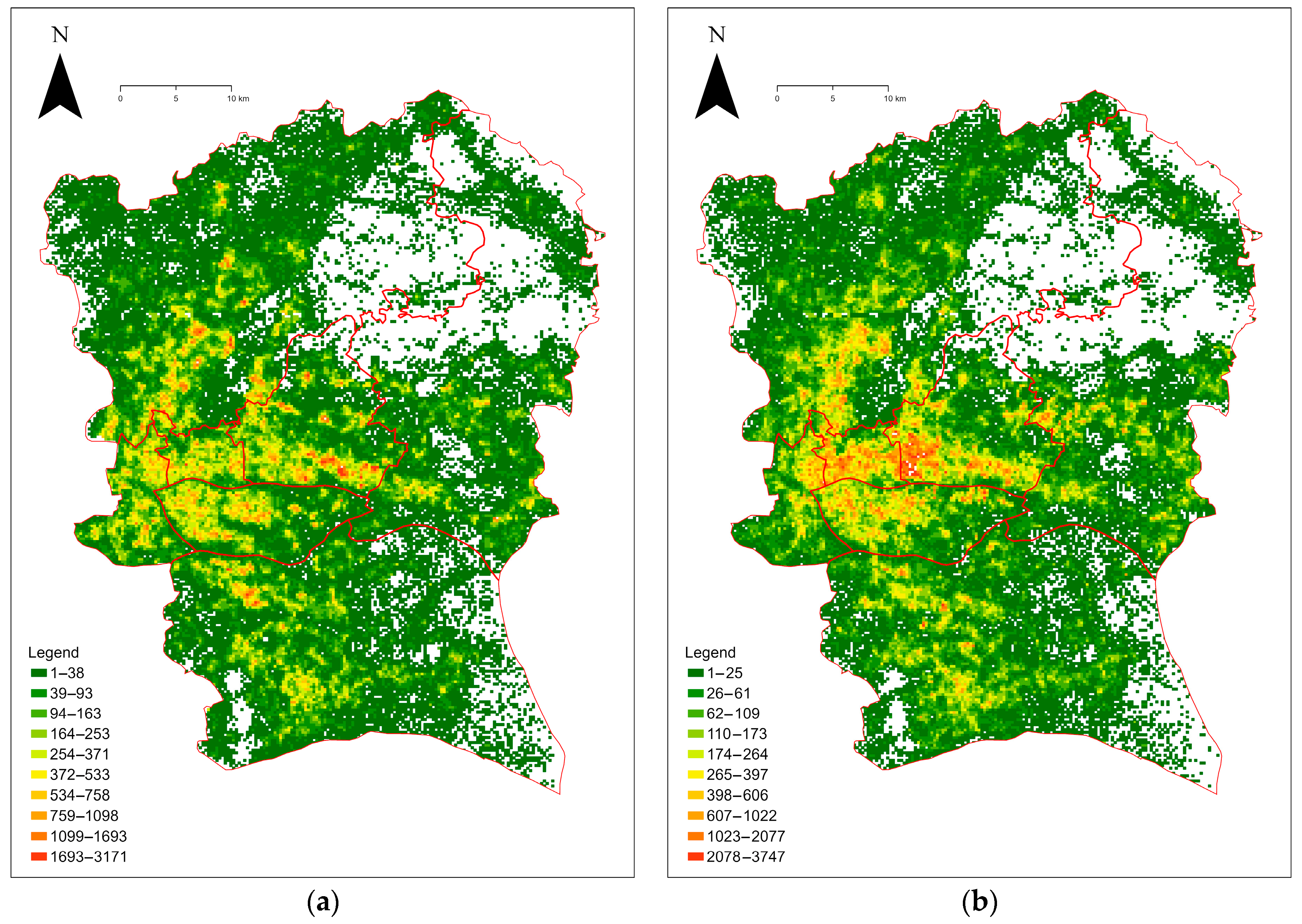
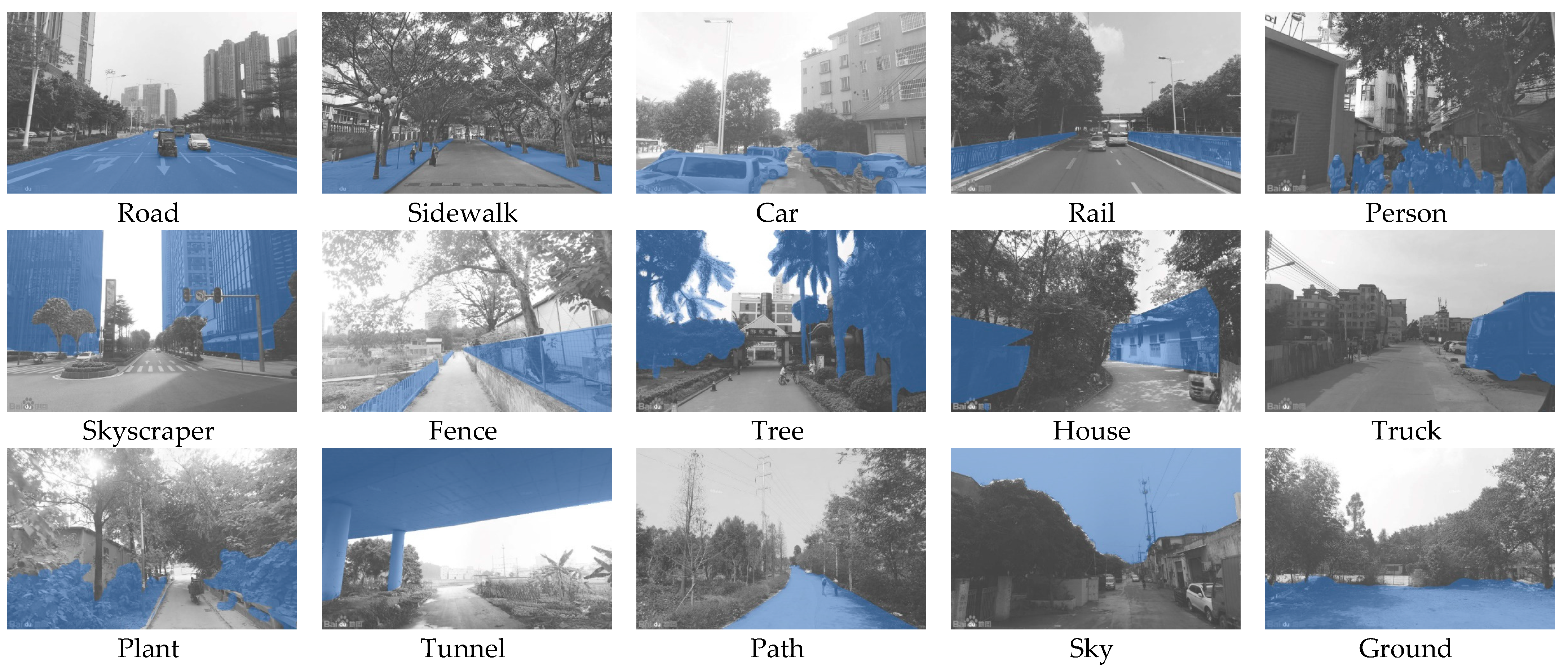
| Group | Description |
|---|---|
| #1 | 20 women, 16 of whom are students and 4 of whom are staff; age range 19–48. |
| #2 | 10 women and 10 men, 8 of whom are women students and 2 of whom are women staff, the same applies to men; age range 18–50. |
| #3 | 10 men, 8 of whom are students and 2 of whom are staff; age range 20–53. |
| FID | Label | Number of Images 1 | Mean 2 | Std. | Min | Max |
|---|---|---|---|---|---|---|
| 1 | Sky | 165,734 | 26.03% | 16.37% | 0.00% | 77.26% |
| 2 | Tree | 160,034 | 23.94% | 17.85% | 0.00% | 91.86% |
| 3 | Building | 158,985 | 16.68% | 17.71% | 0.00% | 92.24% |
| 4 | Road | 161,936 | 14.11% | 7.81% | 0.00% | 57.44% |
| 5 | Unknown objects | 165,312 | 4.05% | 5.12% | 0.00% | 48.04% |
| 6 | Car | 142,345 | 3.00% | 3.91% | 0.00% | 29.75% |
| 7 | Sidewalk | 148,635 | 2.81% | 3.55% | 0.00% | 41.25% |
| 8 | Wall | 108,003 | 1.53% | 3.52% | 0.00% | 39.52% |
| 9 | Plant | 105,019 | 1.46% | 2.70% | 0.00% | 30.41% |
| 10 | Grass | 89,403 | 1.12% | 2.30% | 0.00% | 30.24% |
| 11 | Fence | 97,347 | 0.94% | 1.81% | 0.00% | 20.79% |
| 12 | Ground | 69,970 | 0.62% | 1.85% | 0.00% | 42.64% |
| 13 | Ceiling | 11,826 | 0.55% | 3.72% | 0.00% | 58.98% |
| 14 | Bridge | 28,795 | 0.32% | 1.62% | 0.00% | 44.85% |
| 15 | Truck | 34,996 | 0.28% | 1.30% | 0.00% | 32.77% |
| 16 | Signboard | 80,321 | 0.27% | 0.72% | 0.00% | 21.29% |
| 17 | Person | 69,339 | 0.23% | 0.68% | 0.00% | 22.81% |
| 18 | Bus | 21,358 | 0.20% | 1.24% | 0.00% | 37.92% |
| 19 | Rail | 32,861 | 0.17% | 0.69% | 0.00% | 17.40% |
| 20 | Skyscraper | 6121 | 0.15% | 1.27% | 0.00% | 49.15% |
| 21 | Path | 18,222 | 0.15% | 0.92% | 0.00% | 26.92% |
| 22 | Floor | 19,024 | 0.14% | 0.98% | 0.00% | 51.34% |
| 23 | Van | 28,575 | 0.12% | 0.57% | 0.00% | 17.18% |
| 24 | Mountain | 15,079 | 0.09% | 0.71% | 0.00% | 30.69% |
| 25 | House | 10,859 | 0.07% | 0.76% | 0.00% | 59.45% |
| 26 | Water | 10,596 | 0.07% | 0.61% | 0.00% | 24.05% |
| 27 | Tower | 7861 | 0.06% | 0.63% | 0.00% | 48.10% |
| 28 | Window | 6654 | 0.06% | 0.57% | 0.00% | 23.93% |
| 29 | Pole | 34,110 | 0.05% | 0.19% | 0.00% | 3.00% |
| 30 | Motorbike | 16,776 | 0.05% | 0.26% | 0.00% | 13.53% |
| 31 | Bike | 14,673 | 0.04% | 0.28% | 0.00% | 17.57% |
| 32 | Sunblind | 10,174 | 0.04% | 0.28% | 0.00% | 12.87% |
References
- Mocák, P.; Kvetoslava, M.; René, M.; János, P.; Piotr, P.; Mishra, P.K.; Katarína, K.; Michaela, D. 15-minute city concept as a sustainable urban development alternative: A brief outline of conceptual frameworks and Slovak cities as a case. Folia Geogr. 2022, 64, 69. [Google Scholar]
- Abusaada, H.; Elshater, A. Effect of people on placemaking and affective atmospheres in city streets. Ain Shams Eng. J. 2021, 12, 3389–3403. [Google Scholar] [CrossRef]
- Saelens, B.E.; Handy, S.L. Built Environment Correlates of Walking: A Review. Med. Sci. Sport. Exerc. 2008, 40, S550. [Google Scholar] [CrossRef]
- Wang, R.; Yuan, Y.; Liu, Y.; Zhang, J.; Liu, P.; Lu, Y.; Yao, Y. Using street view data and machine learning to assess how perception of neighborhood safety influences urban residents’ mental health. Health Place 2019, 59, 102186. [Google Scholar] [CrossRef]
- Michael, W.M.; Yulia, K.; Andrew, R.; Nikos Angelos, S. A New Pattern Language for Growing Regions: Places, Networks, Processes; Sustasis Press: Portland, OR, USA, 2019. [Google Scholar]
- Zhang, F.; Zhou, B.; Liu, L.; Liu, Y.; Fung, H.H.; Lin, H.; Ratti, C. Measuring human perceptions of a large-scale urban region using machine learning. Landsc. Urban Plan. 2018, 180, 148–160. [Google Scholar] [CrossRef]
- Ramírez, T.; Hurtubia, R.; Lobel, H.; Rossetti, T. Measuring heterogeneous perception of urban space with massive data and machine learning: An application to safety. Landsc. Urban Plan. 2021, 208, 104002. [Google Scholar] [CrossRef]
- Qiu, W.; Zhang, Z.; Liu, X.; Li, W.; Li, X.; Xu, X.; Huang, X. Subjective or objective measures of street environment, which are more effective in explaining housing prices? Landsc. Urban Plan. 2022, 221, 104358. [Google Scholar] [CrossRef]
- Wang, L.; Han, X.; He, J.; Jung, T. Measuring residents’ perceptions of city streets to inform better street planning through deep learning and space syntax. ISPRS J. Photogramm. Remote Sens. 2022, 190, 215–230. [Google Scholar] [CrossRef]
- Akgün-Tanbay, N.; Campisi, T.; Tanbay, T.; Tesoriere, G.; Dissanayake, D. Modelling Road User Perceptions towards Safety, Comfort, and Chaos at Shared Space: The via Maqueda Case Study, Italy. J. Adv. Transp. 2022, 2022, 4979496. [Google Scholar] [CrossRef]
- Cordellieri, P.; Baralla, F.; Ferlazzo, F.; Sgalla, R.; Piccardi, L.; Giannini, A.M. Gender Effects in Young Road Users on Road Safety Attitudes, Behaviors and Risk Perception. Front. Psychol. 2016, 7, 1412. [Google Scholar] [CrossRef]
- Kimic, K.; Polko, P. The Use of Urban Parks by Older Adults in the Context of Perceived Security. Int. J. Environ. Res. Public Health 2022, 19, 4184. [Google Scholar] [CrossRef] [PubMed]
- Pajković, V.; Grdinić-Rakonjac, M. Age-related differences in attitudes and perception on road safety issues in Montenegro. Transp. Res. Procedia 2022, 60, 584–591. [Google Scholar] [CrossRef]
- Jorgensen, L.J.; Ellis, G.D.; Ruddell, E. Fear Perceptions in Public Parks: Interactions of Environmental Concealment, the Presence of People Recreating, and Gender. Environ. Behav. 2012, 45, 803–820. [Google Scholar] [CrossRef]
- Xu, L.; Jiang, W.; Chen, Z. Study on Perceived Safety in Public Spaces: Take Perception of Stree View in Shanghai as an Example. Landsc. Archit. 2018, 25, 23–29. (In Chinese) [Google Scholar] [CrossRef]
- Nasar, J.L. Safe cities: Guidelines for planning, design, and management. Am. Plan. Association. J. Am. Plan. Assoc. 1996, 62, 142. [Google Scholar]
- Heng, H. Safe Cities for and by Women: Development of the Topic in Spatial Research and Practice. New Archit. 2021, 1, 22–26. Available online: https://kns.cnki.net/kcms/detail/detail.aspx?FileName=XJZJ202101005&DbName=CJFQ2021 (accessed on 9 August 2022). (In Chinese).
- Wekerle, G. Gender planning in public transit: Institutionalizing feminist policies, changing discourse, and practices. In Gender and Planning: A Reader; Rutgers University Press: New Brunswick, NJ, USA, 2005; pp. 275–295. [Google Scholar]
- Yue, H.; Xie, H.; Liu, L.; Chen, J. Detecting People on the Street and the Streetscape Physical Environment from Baidu Street View Images and Their Effects on Community-Level Street Crime in a Chinese City. ISPRS Int. J. Geo-Inf. 2022, 11, 151. [Google Scholar] [CrossRef]
- Zhang, F.; Fan, Z.; Kang, Y.; Hu, Y.; Ratti, C. “Perception bias”: Deciphering a mismatch between urban crime and perception of safety. Landsc. Urban Plan. 2021, 207, 104003. [Google Scholar] [CrossRef]
- Xu, S.; Li, S.; Wen, R. Sensing and detecting traffic events using geosocial media data: A review. Comput. Environ. Urban Syst. 2018, 72, 146–160. [Google Scholar] [CrossRef]
- Dubey, A.; Naik, N.; Parikh, D.; Raskar, R.; Hidalgo, C.A. Deep Learning the City: Quantifying Urban Perception at a Global Scale. In Proceedings of the Computer Vision—ECCV 2016, Amsterdam, The Netherlands, 11–14 October 2016; pp. 196–212. [Google Scholar]
- Naik, N.; Philipoom, J.; Raskar, R.; Hidalgo, C. Streetscore—Predicting the Perceived Safety of One Million Streetscapes. In Proceedings of the 2014 IEEE Conference on Computer Vision and Pattern Recognition Workshops, Columbus, OH, USA, 23–28 June 2014; pp. 793–799. [Google Scholar]
- Carmona, M.; Gabrieli, T.; Hickman, R.; Laopoulou, T.; Livingstone, N. Street appeal: The value of street improvements. Prog. Plan. 2018, 126, 1–51. [Google Scholar] [CrossRef]
- Li, X.; Ratti, C.; Seiferling, I. Mapping Urban Landscapes Along Streets Using Google Street View. In Proceedings of the Advances in Cartography and GIScience, Washington, DC, USA, 2–7 July 2017; pp. 341–356. [Google Scholar]
- Wekerle, G.; Whitzman, C. Safe Cities: Guidelines for Planning, Design and Management; Van Nostrand Reinhold: New York, NY, USA, 1995. [Google Scholar]
- Laufs, J.; Borrion, H.; Bradford, B. Security and the smart city: A systematic review. Sustain. Cities Soc. 2020, 55, 102023. [Google Scholar] [CrossRef]
- Jeffery, C.R. Crime Prevention through Environmental Design; Sage Publications: Beverly Hills, CA, USA, 1977; Volume 524. [Google Scholar]
- Newman, O. Creating Defensible Space; Diane Publishing: Collingdale, PA, USA, 1996. [Google Scholar]
- Matlovičová, K.; Mocák, P.; Kolesárová, J. Environment of estates and crime prevention through urban environment formation and modification. Geogr. Pannonica 2016, 20, 168–180. [Google Scholar] [CrossRef]
- Jacobs, J. The Death and Life of Great American Cities; Random House: New York, NY, USA, 1961. [Google Scholar]
- Gekoski, A.; Gray, J.M.; Adler, J.R.; Horvath, M.A.H. The prevalence and nature of sexual harassment and assault against women and girls on public transport: An international review. J. Criminol. Res. Policy Pract. 2017, 3, 3–16. [Google Scholar] [CrossRef]
- Davidson, M.M.; Butchko, M.S.; Robbins, K.; Sherd, L.W.; Gervais, S.J. The mediating role of perceived safety on street harassment and anxiety. Psychol. Violence 2016, 6, 553. [Google Scholar] [CrossRef]
- Concern, C. People’s Perceptions of Personal Security and Their Concerns about Crime on Public Transport; Department for Transport: London, UK, 2004. [Google Scholar]
- Borker, G. Safety First: Perceived Risk of Street Harassment and Educational Choices of Women; World Bank: Washington, DC, USA, 2021. [Google Scholar]
- Chestnutt, R.; Berlin, S.F.S. Gender Mainstreaming in Urban Development: Berlin handbook; Kulturbuch-Verlag: Berlin, Germany, 2011. [Google Scholar]
- City of Vancouver. A City for All Women: Women’s Equity Strategy 2018–2028; City of Vancouve: Vancouver, VA, Canada, 2018. [Google Scholar]
- Li, X.; Zhang, C.; Li, W.; Ricard, R.; Meng, Q.; Zhang, W. Assessing street-level urban greenery using Google Street View and a modified green view index. Urban For. Urban Green. 2015, 14, 675–685. [Google Scholar] [CrossRef]
- Seiferling, I.; Naik, N.; Ratti, C.; Proulx, R. Green streets—Quantifying and mapping urban trees with street-level imagery and computer vision. Landsc. Urban Plan. 2017, 165, 93–101. [Google Scholar] [CrossRef]
- Griew, P.; Hillsdon, M.; Foster, C.; Coombes, E.; Jones, A.; Wilkinson, P. Developing and testing a street audit tool using Google Street View to measure environmental supportiveness for physical activity. Int. J. Behav. Nutr. Phys. Act. 2013, 10, 103. [Google Scholar] [CrossRef]
- Kelly, C.M.; Wilson, J.S.; Baker, E.A.; Miller, D.K.; Schootman, M. Using Google Street View to Audit the Built Environment: Inter-rater Reliability Results. Ann. Behav. Med. 2012, 45, S108–S112. [Google Scholar] [CrossRef] [PubMed]
- Rundle, A.G.; Bader, M.D.M.; Richards, C.A.; Neckerman, K.M.; Teitler, J.O. Using Google Street View to Audit Neighborhood Environments. Am. J. Prev. Med. 2011, 40, 94–100. [Google Scholar] [CrossRef]
- Cui, Q.; Huang, Y.; Yang, G.; Chen, Y. Measuring Green Exposure Levels in Communities of Different Economic Levels at Different Completion Periods: Through the Lens of Social Equity. Int. J. Environ. Res. Public Health 2022, 19, 9611. [Google Scholar] [CrossRef]
- Campbell, A.; Both, A.; Sun, Q. Detecting and mapping traffic signs from Google Street View images using deep learning and GIS. Comput. Environ. Urban Syst. 2019, 77, 101350. [Google Scholar] [CrossRef]
- Chen, L.; Lu, Y.; Sheng, Q.; Ye, Y.; Wang, R.; Liu, Y. Estimating pedestrian volume using Street View images: A large-scale validation test. Comput. Environ. Urban Syst. 2020, 81, 101481. [Google Scholar] [CrossRef]
- Ma, X.; Ma, C.; Wu, C.; Xi, Y.; Yang, R.; Peng, N.; Zhang, C.; Ren, F. Measuring human perceptions of streetscapes to better inform urban renewal: A perspective of scene semantic parsing. Cities 2021, 110, 103086. [Google Scholar] [CrossRef]
- Zhang, K.; Qian, Z.; Yang, Y.; Chen, M.; Zhong, T.; Zhu, R.; Lv, G.; Yan, J. Using street view images to identify road noise barriers with ensemble classification model and geospatial analysis. Sustain. Cities Soc. 2022, 78, 103598. [Google Scholar] [CrossRef]
- Jiang, B.; Mak, C.N.S.; Larsen, L.; Zhong, H. Minimizing the gender difference in perceived safety: Comparing the effects of urban back alley interventions. J. Environ. Psychol. 2017, 51, 117–131. [Google Scholar] [CrossRef]
- Baran, P.K.; Tabrizian, P.; Zhai, Y.; Smith, J.W.; Floyd, M.F. An exploratory study of perceived safety in a neighborhood park using immersive virtual environments. Urban For. Urban Green. 2018, 35, 72–81. [Google Scholar] [CrossRef]
- Li, S.; Dragicevic, S.; Castro, F.A.; Sester, M.; Winter, S.; Coltekin, A.; Pettit, C.; Jiang, B.; Haworth, J.; Stein, A.; et al. Geospatial big data handling theory and methods: A review and research challenges. ISPRS J. Photogramm. Remote Sens. 2016, 115, 119–133. [Google Scholar] [CrossRef]
- Tang, J.; Long, Y. Measuring visual quality of street space and its temporal variation: Methodology and its application in the Hutong area in Beijing. Landsc. Urban Plan. 2019, 191, 103436. [Google Scholar] [CrossRef]
- Cavalcante, A.; Mansouri, A.; Kacha, L.; Barros, A.K.; Takeuchi, Y.; Matsumoto, N.; Ohnishi, N. Measuring streetscape complexity based on the statistics of local contrast and spatial frequency. PLoS ONE 2014, 9, e87097. [Google Scholar] [CrossRef]
- Liu, L.; Silva, E.A.; Wu, C.; Wang, H. A machine learning-based method for the large-scale evaluation of the qualities of the urban environment. Comput. Environ. Urban Syst. 2017, 65, 113–125. [Google Scholar] [CrossRef]
- Han, X.; Wang, L.; Seo, S.H.; He, J.; Jung, T. Measuring Perceived Psychological Stress in Urban Built Environments Using Google Street View and Deep Learning. Front. Public Health 2022, 10, 1295. [Google Scholar] [CrossRef]
- Ye, Y.; Richards, D.; Lu, Y.; Song, X.; Zhuang, Y.; Zeng, W.; Zhong, T. Measuring daily accessed street greenery: A human-scale approach for informing better urban planning practices. Landsc. Urban Plan. 2019, 191, 103434. [Google Scholar] [CrossRef]
- Li, Y.; Xiao, L.; Ye, Y.; Xu, W.; Law, A. Understanding tourist space at a historic site through space syntax analysis: The case of Gulangyu, China. Tour. Manag. 2016, 52, 30–43. [Google Scholar] [CrossRef]
- Becker, R.A.; Caceres, R.; Hanson, K.; Loh, J.M.; Urbanek, S.; Varshavsky, A.; Volinsky, C. A Tale of One City: Using Cellular Network Data for Urban Planning. IEEE Pervasive Comput. 2011, 10, 18–26. [Google Scholar] [CrossRef]
- Shi, L.; Chi, G.; Liu, X.; Liu, Y. Human mobility patterns in different communities: A mobile phone data-based social network approach. Ann. GIS 2015, 21, 15–26. [Google Scholar] [CrossRef]
- Ahas, R.; Aasa, A.; Yuan, Y.; Raubal, M.; Smoreda, Z.; Liu, Y.; Ziemlicki, C.; Tiru, M.; Zook, M. Everyday space–time geographies: Using mobile phone-based sensor data to monitor urban activity in Harbin, Paris, and Tallinn. Int. J. Geogr. Inf. Sci. 2015, 29, 2017–2039. [Google Scholar] [CrossRef]
- Wang, R.; Liu, Y.; Lu, Y.; Zhang, J.; Liu, P.; Yao, Y.; Grekousis, G. Perceptions of built environment and health outcomes for older Chinese in Beijing: A big data approach with street view images and deep learning technique. Comput. Environ. Urban Syst. 2019, 78, 101386. [Google Scholar] [CrossRef]
- Qiu, W.; Li, W.; Liu, X.; Huang, X. Subjectively Measured Streetscape Perceptions to Inform Urban Design Strategies for Shanghai. ISPRS Int. J. Geo-Inf. 2021, 10, 493. [Google Scholar] [CrossRef]
- Jiang, S.; Land, K.C.; Wang, J. Social Ties, Collective Efficacy and Perceived Neighborhood Property Crime in Guangzhou, China. Asian J. Criminol. 2013, 8, 207–223. [Google Scholar] [CrossRef]
- Xiong, H. Urban Spatial Disorganization and Crime: Punctate Distribution Pattern. In Urban Crime and Social Disorganization in China: A Case Study of Three Communities in Guangzhou; Springer: Singapore, 2016; pp. 71–93. [Google Scholar]
- Huang, H. Study on the Spatial Characteristics of Robbery and Snatching Crimes in Guangzhou—An Exploration from an Environmental Criminology Perspective. In Proceedings of the 14th Academic Symposium of the Chinese Society of Criminology, Guiyang, China, 18–19 June 2005; pp. 812–835. (In Chinese). [Google Scholar]
- Yao, Y.; Liang, Z.; Yuan, Z.; Liu, P.; Bie, Y.; Zhang, J.; Wang, R.; Wang, J.; Guan, Q. A human-machine adversarial scoring framework for urban perception assessment using street-view images. Int. J. Geogr. Inf. Sci. 2019, 33, 2363–2384. [Google Scholar] [CrossRef]
- Xu, X.; Qiu, W.; Li, W.; Liu, X.; Zhang, Z.; Li, X.; Luo, D. Associations between Street-View Perceptions and Housing Prices: Subjective vs. Objective Measures Using Computer Vision and Machine Learning Techniques. Remote Sens. 2022, 14, 891. [Google Scholar] [CrossRef]
- Kim, J.H.; Lee, S.; Hipp, J.R.; Ki, D. Decoding urban landscapes: Google street view and measurement sensitivity. Comput. Environ. Urban Syst. 2021, 88, 101626. [Google Scholar] [CrossRef]
- Zhou, B.; Zhao, H.; Puig, X.; Xiao, T.; Fidler, S.; Barriuso, A.; Torralba, A. Semantic Understanding of Scenes through the ADE20K Dataset. Int. J. Comput. Vis. 2019, 127, 302–321. [Google Scholar] [CrossRef]
- Zhao, H.; Shi, J.; Qi, X.; Wang, X.; Jia, J. Pyramid Scene Parsing Network. In Proceedings of the 2017 IEEE Conference on Computer Vision and Pattern Recognition (CVPR), Honolulu, HI, USA, 21–26 July 2017; pp. 6230–6239. [Google Scholar]
- Hankey, S.; Zhang, W.; Le, H.T.K.; Hystad, P.; James, P. Predicting bicycling and walking traffic using street view imagery and destination data. Transp. Res. Part D Transp. Environ. 2021, 90, 102651. [Google Scholar] [CrossRef]
- Safat, W.; Asghar, S.; Gillani, S.A. Empirical Analysis for Crime Prediction and Forecasting Using Machine Learning and Deep Learning Techniques. IEEE Access 2021, 9, 70080–70094. [Google Scholar] [CrossRef]
- Guangzhou Transport Department. Guangzhou Monthly Transport Report; Guangzhou Transport Department: Guangzhou, China, 2020. [Google Scholar]
- Zhou, H.; Liu, L.; Lan, M.; Zhu, W.; Song, G.; Jing, F.; Zhong, Y.; Su, Z.; Gu, X. Using Google Street View imagery to capture micro built environment characteristics in drug places, compared with street robbery. Comput. Environ. Urban Syst. 2021, 88, 101631. [Google Scholar] [CrossRef]
- Shanghai Planning Guidance of 15-Minute Community-Life Circle; Shanghai Urban Planning and Land Resources Administration Bureau: Shanghai, China, 2016.
- Wilson, J.Q.; Kelling, G.L. The police and neighborhood safety Broken Windows. In Social, Ecological and Environmental Theories of Crime; Routledge: London, UK, 2017; pp. 169–178. [Google Scholar]
- Xiao, T.; Li, D.; Wan, Y.; Jin, R.; Wang, Z.; Gao, W.; Fei, Y. Research on Urban Street Safety Based on Street View Images and Mobile Signaling Data. Geogr. Geo-Inf. Sci. 2022, 38, 71–78. Available online: https://kns.cnki.net/kcms/detail/detail.aspx?FileName=DLGT202201011&DbName=CJFQ2022 (accessed on 3 August 2022). (In Chinese).
- Li, Y.; Yabuki, N.; Fukuda, T. Measuring visual walkability perception using panoramic street view images, virtual reality, and deep learning. Sustain. Cities Soc. 2022, 86, 104140. [Google Scholar] [CrossRef]
- Du, Y.; Huang, W. Evaluation of Street Space Quality Using Streetscape Data: Perspective from Recreational Physical Activity of the Elderly. ISPRS Int. J. Geo-Inf. 2022, 11, 241. [Google Scholar] [CrossRef]
- Yin, L.; Wang, Z. Measuring visual enclosure for street walkability: Using machine learning algorithms and Google Street View imagery. Appl. Geogr. 2016, 76, 147–153. [Google Scholar] [CrossRef]
- Wang, R.; Lu, Y.; Zhang, J.; Liu, P.; Yao, Y.; Liu, Y. The relationship between visual enclosure for neighbourhood street walkability and elders’ mental health in China: Using street view images. J. Transp. Health 2019, 13, 90–102. [Google Scholar] [CrossRef]
- Jansson, C. Factors Important to Street Users’ Perceived Safety on a Main Street (Dissertation). 2019. Available online: http://urn.kb.se/resolve?urn=urn:nbn:se:kth:diva-260049 (accessed on 6 March 2023).
- China Institute of New Urbanization Tsinghua University; Vanke School of Public Health and Wellness. Tsinghua Urban Health Environment Index; China Institute of New Urbanization Tsinghua University: Qingdao, China, 2021. (In Chinese) [Google Scholar]
- Blöbaum, A.; Hunecke, M. Perceived Danger in Urban Public Space: The Impacts of Physical Features and Personal Factors. Environ. Behav. 2005, 37, 465–486. [Google Scholar] [CrossRef]
- Rossetti, T.; Lobel, H.; Rocco, V.; Hurtubia, R. Explaining subjective perceptions of public spaces as a function of the built environment: A massive data approach. Landsc. Urban Plan. 2019, 181, 169–178. [Google Scholar] [CrossRef]
- Alexander, C. A Pattern Language: Towns, Buildings, Construction; Oxford University Press: Oxford, UK, 1977. [Google Scholar]
- Li, Y.; Yabuki, N.; Fukuda, T. Exploring the association between street built environment and street vitality using deep learning methods. Sustain. Cities Soc. 2022, 79, 103656. [Google Scholar] [CrossRef]
- Llinares, C.; Higuera-Trujillo, J.L.; Montañana, A.; Castilla, N. Improving the Pedestrian’s Perceptions of Safety on Street Crossings. Psychological and Neurophysiological Effects of Traffic Lanes, Artificial Lighting, and Vegetation. Int. J. Environ. Res. Public Health 2020, 17, 8576. [Google Scholar] [CrossRef] [PubMed]
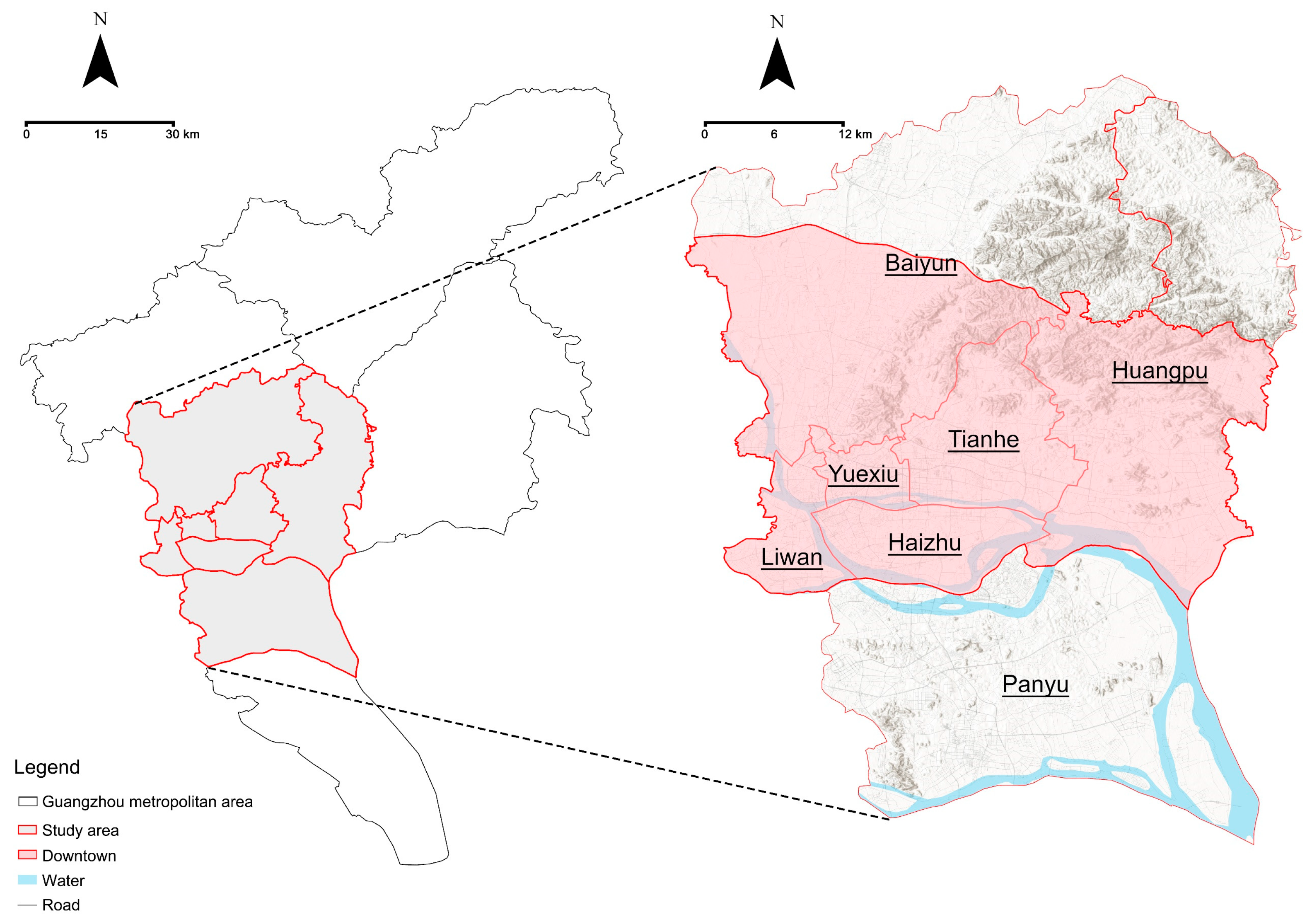
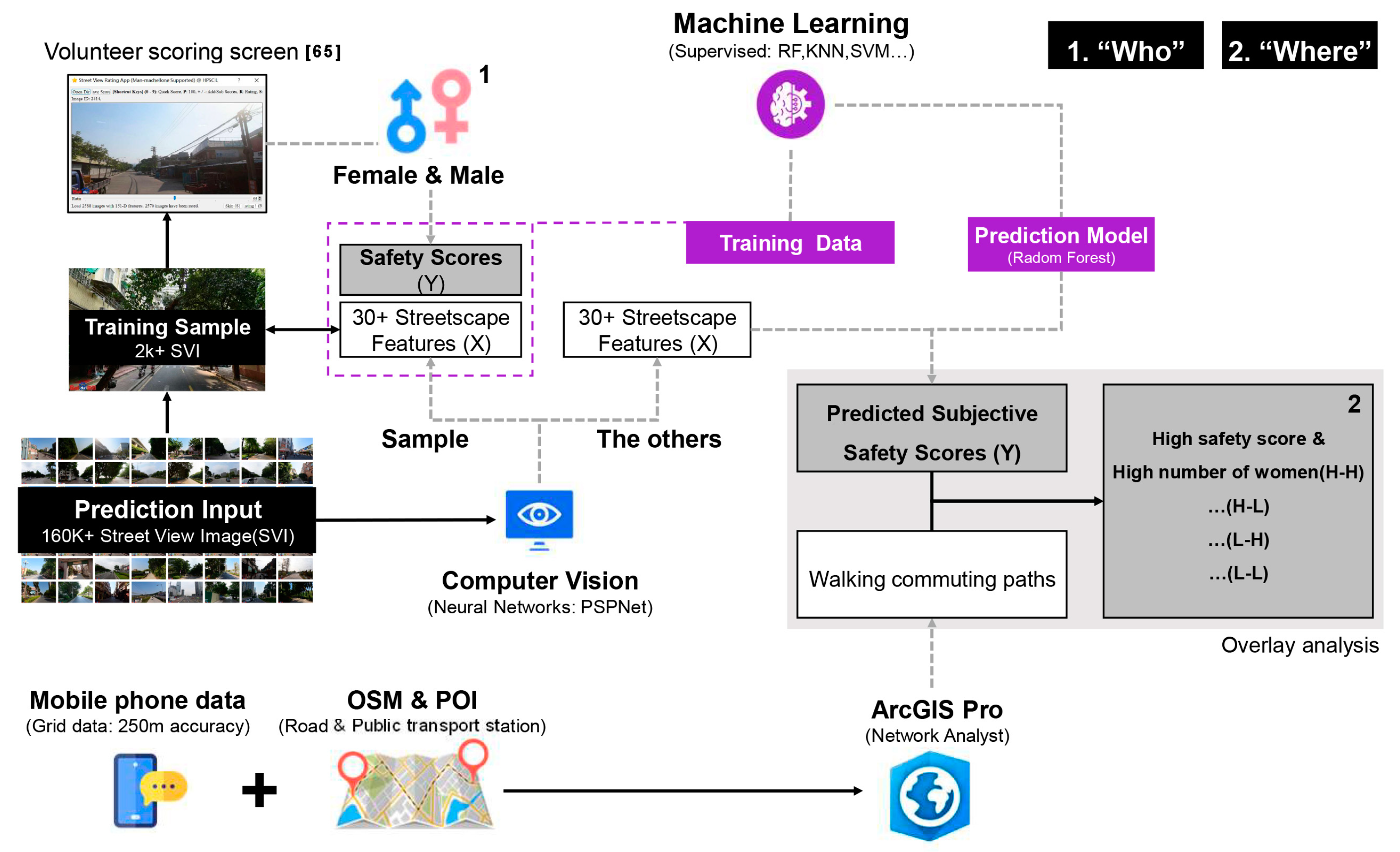
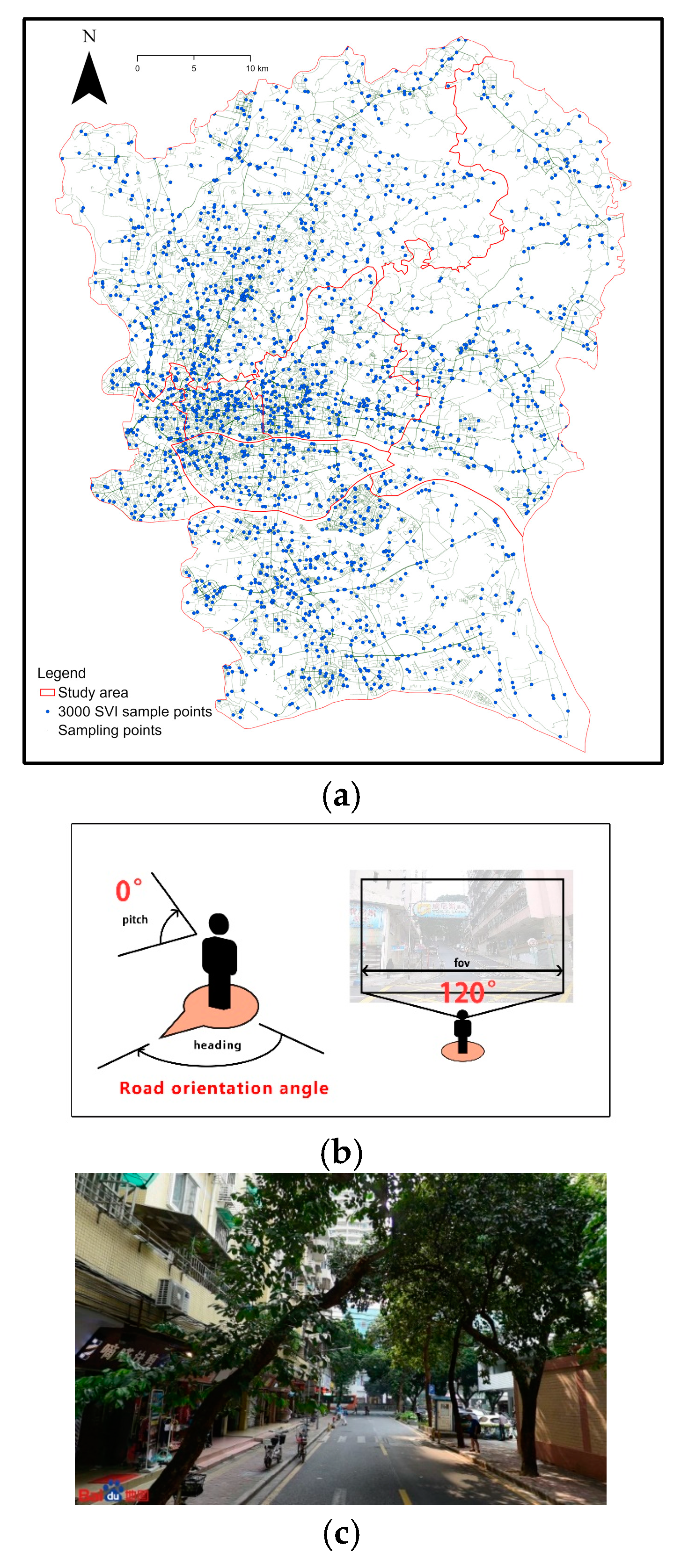

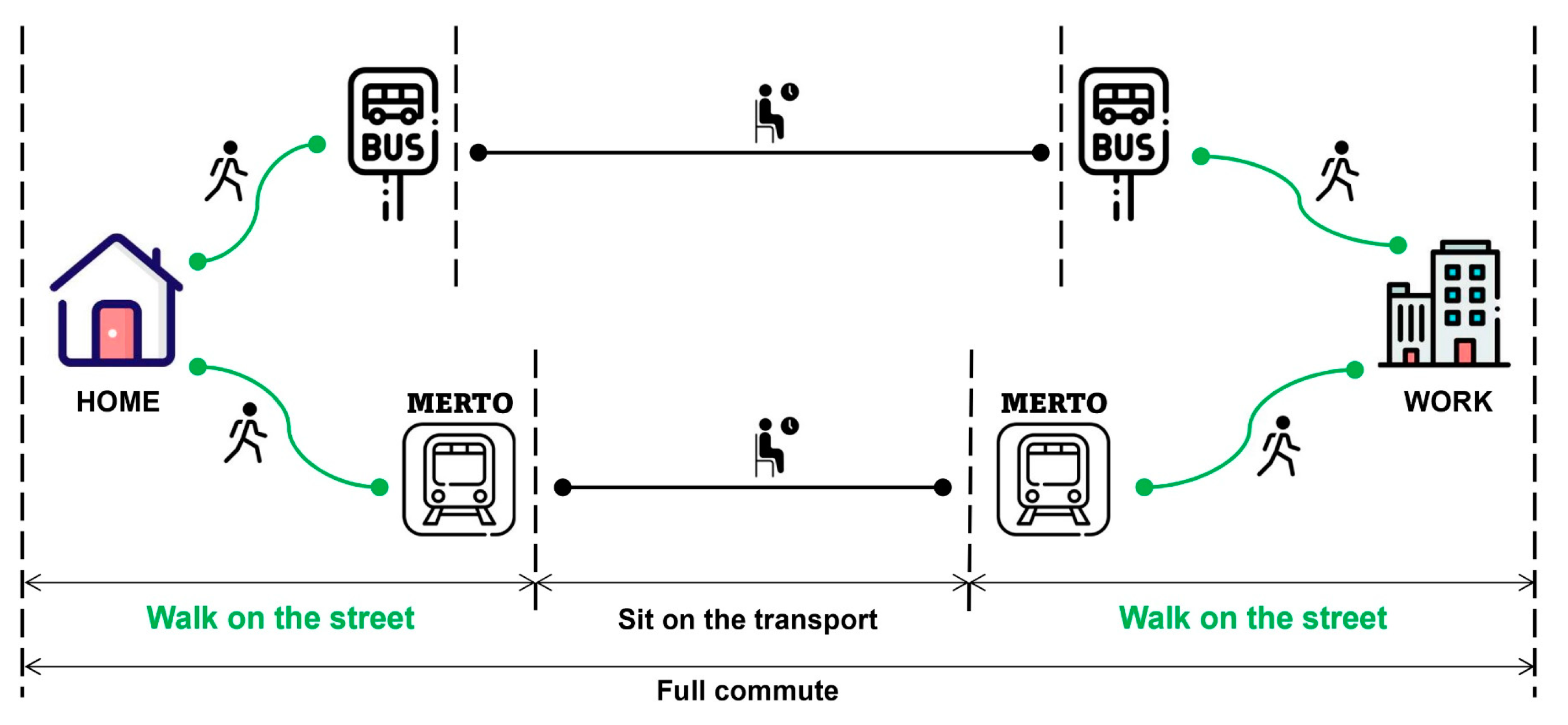
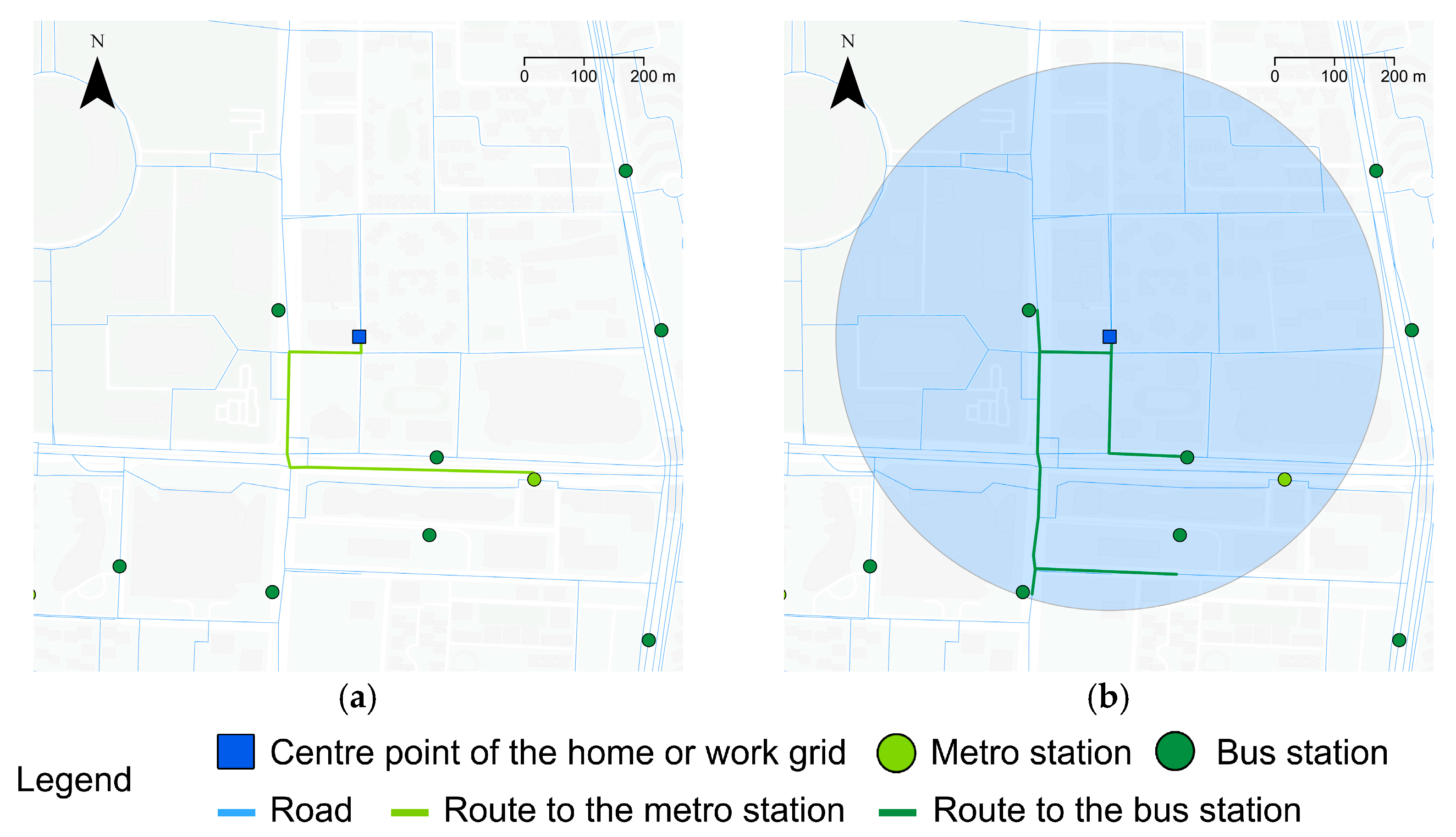


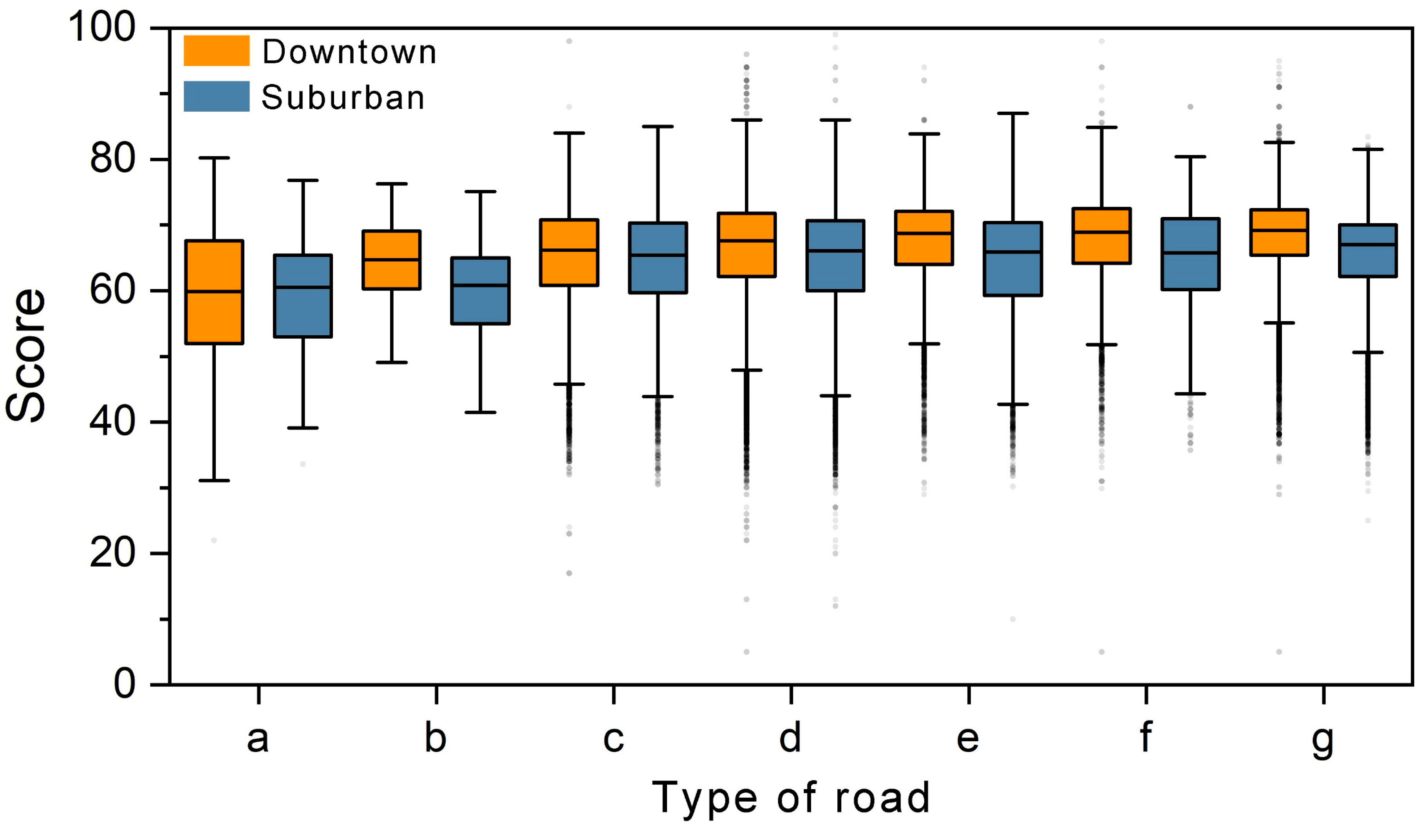
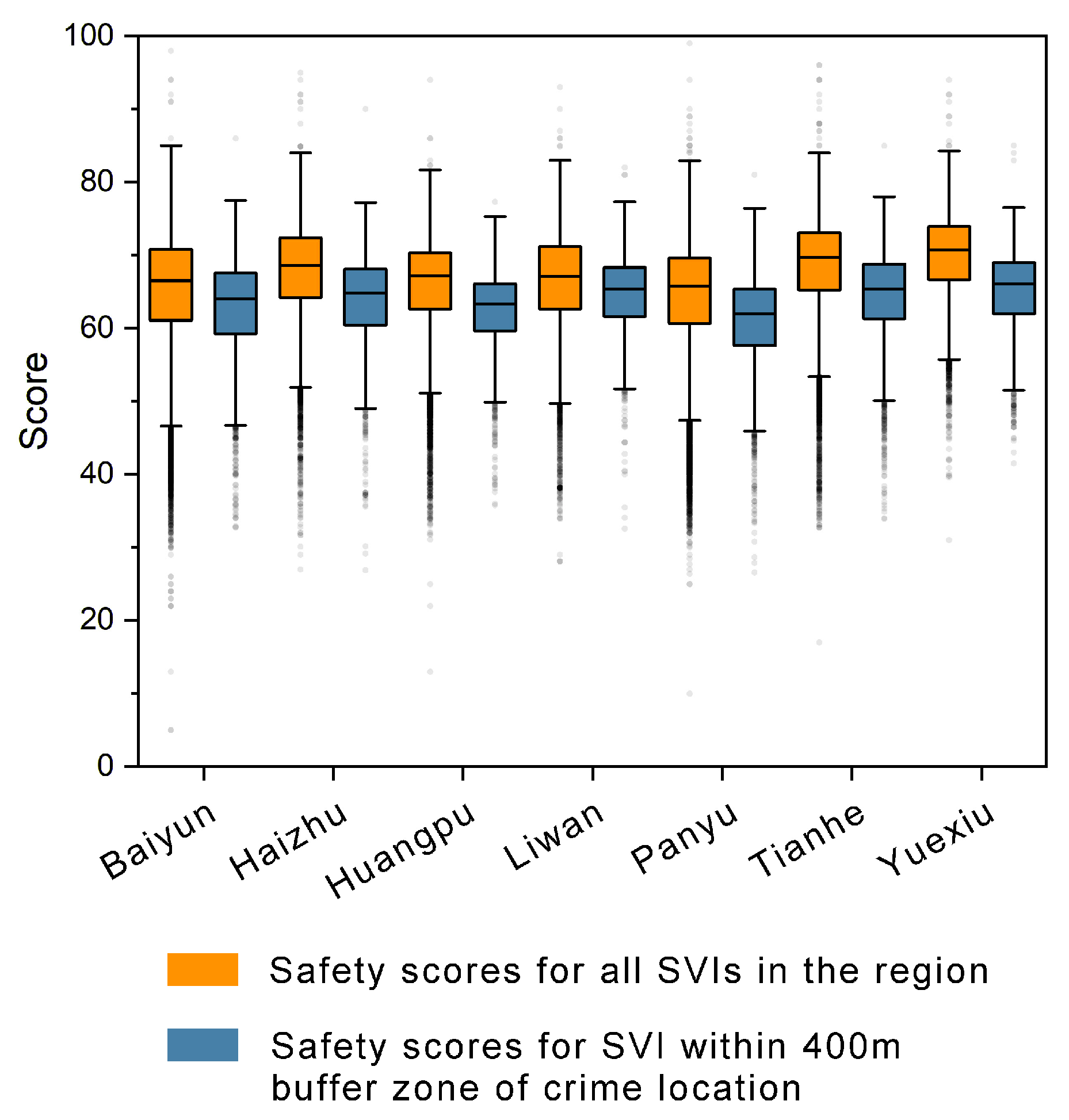

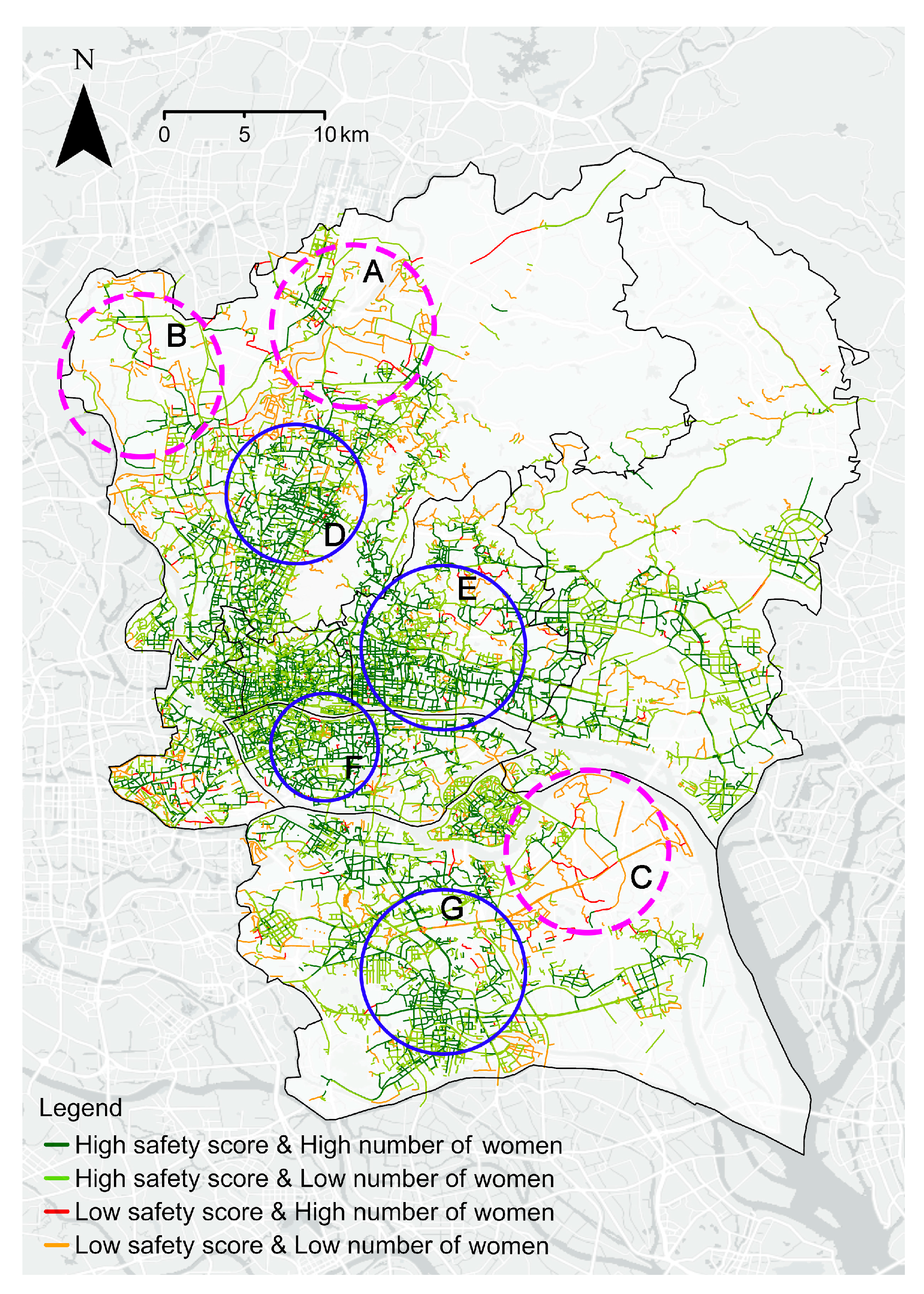
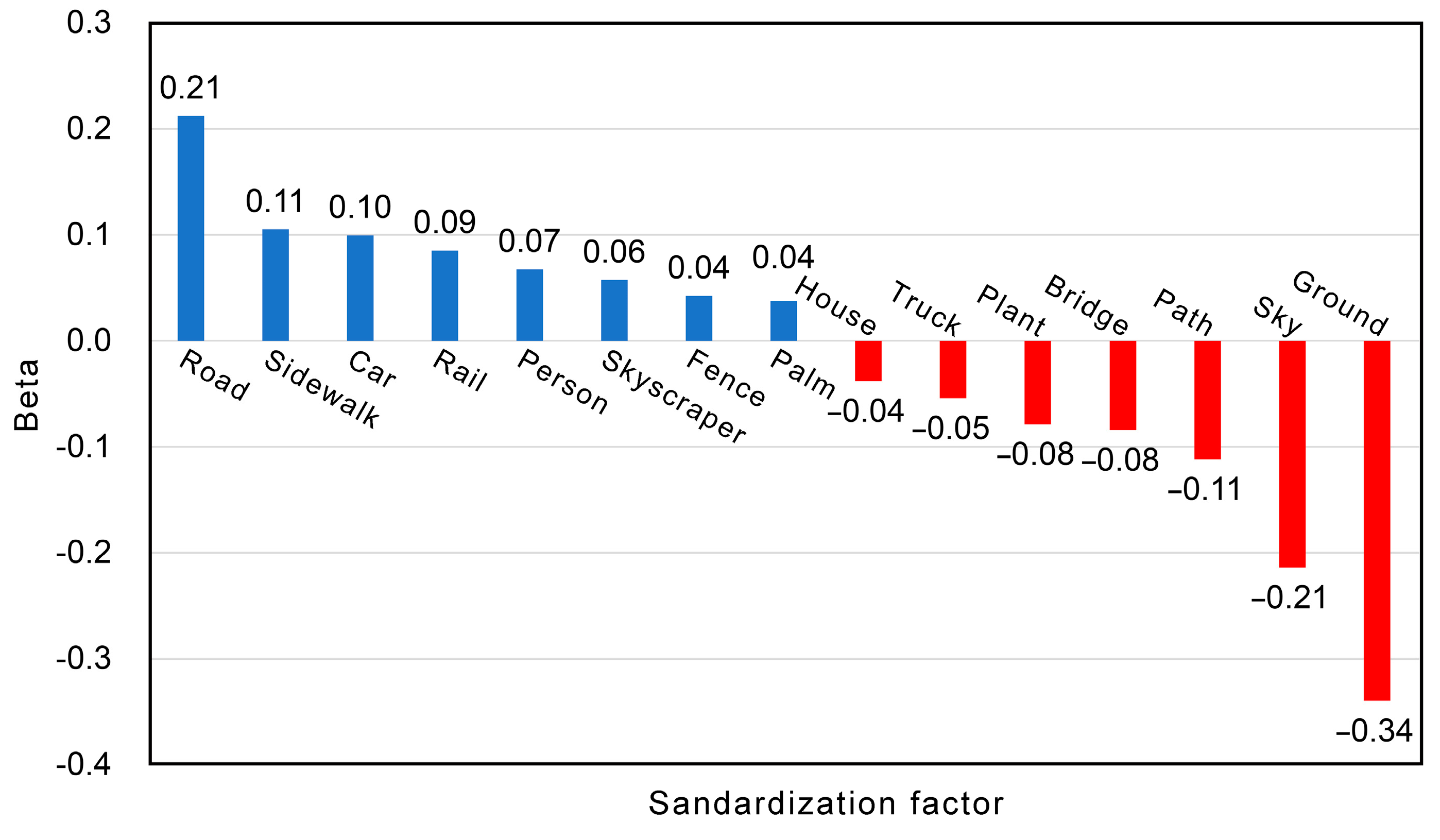
| FID | Gender | Population Weight | Home net_id | Work net_id |
|---|---|---|---|---|
| 1 | Male | 5.654 | 21797 | 38258 |
| 2 | Female | 5.474 | 21797 | 21797 |
| 3 | Male | 4.982 | 22529 | 25701 |
| … | … | … | … | … |
| N | Female | 6.797 | 24966 | 27906 |
| Model | RMSE | MAE |
|---|---|---|
| K-nearest neighbours (KNN) | 10.0 | 7.6 |
| Support vector machine (SVM) | 9.2 | 6.9 |
| Radom forest (RF) | 8.8 | 6.5 |
| Decision tree (DT) | 11.2 | 7.6 |
| Ordinary least squares (OLS) | 9.8 | 7.4 |
| Gaussian process regressor (GPR) | 9.8 | 7.4 |
| Voting selection (VS) | 8.9 | 6.8 |
| Adaptive boost (ADAB) | 9.7 | 7.4 |
| Bagging regression (BR) | 9.2 | 6.9 |
| Type | Number of Streets | PCT | Street Lengths (km) | PCT | Mean Lengths (m) |
|---|---|---|---|---|---|
| High safety score and High number of women | 16,908 | 47.1% | 2789.9 | 43.8% | 165.0 |
| High safety score and Low number of women | 15,053 | 41.9% | 2727.2 | 42.8% | 181.2 |
| Low safety score and High number of women | 1050 | 2.9% | 155.2 | 2.4% | 147.8 |
| Low safety score and Low number of women | 2895 | 8.1% | 692.7 | 10.9% | 239.3 |
Disclaimer/Publisher’s Note: The statements, opinions and data contained in all publications are solely those of the individual author(s) and contributor(s) and not of MDPI and/or the editor(s). MDPI and/or the editor(s) disclaim responsibility for any injury to people or property resulting from any ideas, methods, instructions or products referred to in the content. |
© 2023 by the authors. Licensee MDPI, Basel, Switzerland. This article is an open access article distributed under the terms and conditions of the Creative Commons Attribution (CC BY) license (https://creativecommons.org/licenses/by/4.0/).
Share and Cite
Cui, Q.; Gong, P.; Yang, G.; Zhang, S.; Huang, Y.; Shen, S.; Wei, B.; Chen, Y. Women-Oriented Evaluation of Perceived Safety of Walking Routes between Home and Mass Transit: A Case Study and Methodology Test in Guangzhou. Buildings 2023, 13, 715. https://doi.org/10.3390/buildings13030715
Cui Q, Gong P, Yang G, Zhang S, Huang Y, Shen S, Wei B, Chen Y. Women-Oriented Evaluation of Perceived Safety of Walking Routes between Home and Mass Transit: A Case Study and Methodology Test in Guangzhou. Buildings. 2023; 13(3):715. https://doi.org/10.3390/buildings13030715
Chicago/Turabian StyleCui, Qinyu, Pixin Gong, Guang Yang, Shuyu Zhang, Yiting Huang, Shixuan Shen, Bingcai Wei, and Yu Chen. 2023. "Women-Oriented Evaluation of Perceived Safety of Walking Routes between Home and Mass Transit: A Case Study and Methodology Test in Guangzhou" Buildings 13, no. 3: 715. https://doi.org/10.3390/buildings13030715
APA StyleCui, Q., Gong, P., Yang, G., Zhang, S., Huang, Y., Shen, S., Wei, B., & Chen, Y. (2023). Women-Oriented Evaluation of Perceived Safety of Walking Routes between Home and Mass Transit: A Case Study and Methodology Test in Guangzhou. Buildings, 13(3), 715. https://doi.org/10.3390/buildings13030715







